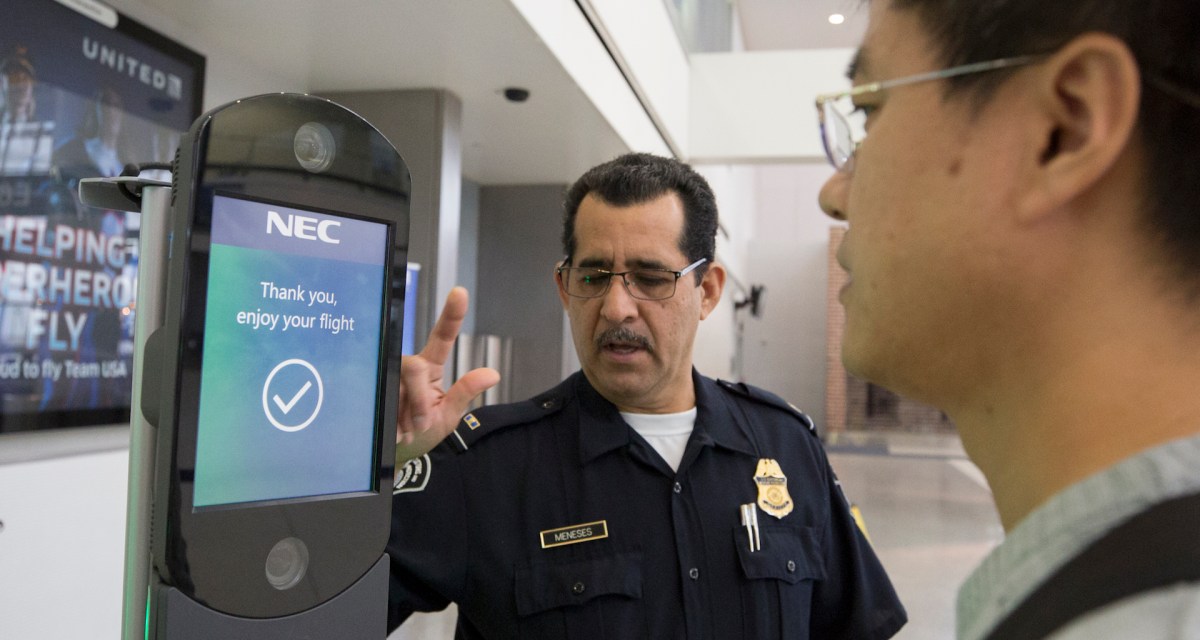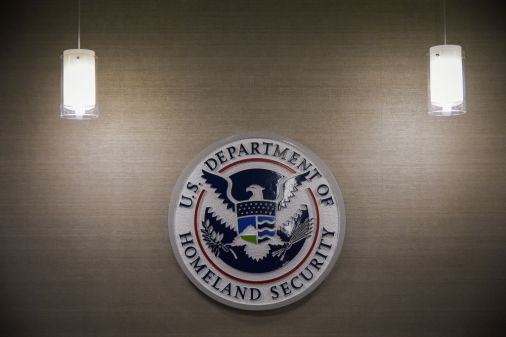CBP leaning into biometrics on controversial app, raising concerns from immigrant rights advocates

U.S. Customs and Border Protection plans to expand the use of biometrics through its CBP One app, a platform created by the agency to help process people who intend to come to the country that has raised concerns from immigrant rights groups. The expansion of biometrics — and in particular, personal data about peoples’ faces — comes amid ongoing issues with the app’s technical capabilities.
The disclosure, published to the Federal Register last month, states that CBP is introducing a new biometric capability into the app that’s meant to accelerate the Department of Homeland Security’s effort to collect biometric information from nonimmigrants leaving the country, requiring a “selfie” photo with geolocation tracking to confirm that they’ve actually departed. The update is also intended to decrease travel document fraud and improve the agency’s “ability to identify criminals and known or suspected terrorists.”
The app’s update would allow nonimmigrants who are departing the U.S. to “voluntarily provide biographical data, facial images and geolocation,” a step that aligns with a Department of Homeland Security mandate to collect biometric information and support CBP’s plan to fully automate I-94 collection. Individuals are subject to Form I-94 if they are nonimmigrant U.S. visitors; CBP issues I-94 forms to individuals at the time that they “lawfully enter” the U.S., serving as an arrival and departure record.
“Having proof of an exit via the CBP One app would provide nonimmigrants some information for CBP officers to consider in the event the officer is unsure whether a nonimmigrant complied with the I-94 requirements provided upon their previous entry,” the notice reads.
Additionally, CBP stated its intention to update the Electronic System for Travel Authorization website to require applicants to provide a selfie along with the already required passport biographical page photo.
The new disclosure also mentions a “liveness detection” feature that’s meant to confirm that the photo is recent and not an older photo. That information, according to the Federal Register posting, is supposed to be filed in the Arrival and Departure Information System, a travel history database that CBP is pushing to expand, according to a privacy impact assessment for the platform.
The CBP One expansion comes after the agency in September announced plans to utilize the technology before someone arrives in the United States. That information, according to the disclosure, is supposed to be shared with U.S. Citizenship and Immigration Services and air carriers working with CBP’s document validation initiative. In this case, photos sent to the app are, for instance, scanned with a facial recognition algorithm and uploaded to a Traveler Verification System gallery and the Automated Targeting System, which is used to compare traveler information to other law enforcement data, according to a privacy impact assessment published at the beginning of last year.
“Noncitizens are able to use the CBP One mobile application to schedule an appointment at one of seven Southwest Border [ports of entry] and present themselves for inspection to a CBP officer,” Benjamine “Carry” Huffman, then-acting deputy commissioner at CBP, said during a border-focused House hearing last year. “The ability to use the app cuts out the smugglers, decreases migrant exploitation, and makes processing more efficient upon arrival at the [ports of entry].”
After publication of this story, and more than two weeks after FedScoop reached out for comment, a CBP spokesperson said in an email that the app digitally serves travelers who need to interact with the agency, and permits them to do things such as provide advance notice of the import of biological materials, apply and pay for an I-94 document, and schedule perishable cargo exams.
Additionally, migrants located in Central or North Mexico who do not have sufficient admission documentation can make an appointment and remain in place until presenting for their appointment. This cuts down on migrant crowding in immediate border areas, according to the spokesperson.
The app’s appointment scheduling functionality, according to the spokesperson, has increased CBP’s capacity to process migrants and cut down on bad actors who could endanger and take advantage of vulnerable migrants.
The purpose of this system, according to the agency’s September posting, is to confirm the identity of someone entering the U.S. and to run that information against potential criminal databases. That disclosure also noted new CBP One applications for certain nationals of countries like Haiti and Colombia, as well as a new program for Ukrainians.
Yet the CBP disclosure from late February is new in that it applies biometrics to those exiting the United States, rather than those entering. Though no time frame is specified, the posting puts the number of respondents expected to use the CBP One in the hundreds of thousands. This expansion only adds to concerns held by immigration rights groups.
“We are concerned about the ever-expanding surveillance capabilities and requirements that CBP is adding to CBP One. With little notice or oversight, CBP has expanded biometric and geolocation surveillance to individuals not even in the U.S.,” Julie Mao, the co-founder and deputy director of Just Futures Law, a legal organization that focuses on immigrant rights, said in an email to FedScoop.
She continued: “What business and for that matter legal authority does CBP have to conduct such biometrics and geolocation capture outside the U.S.? This is part of DHS’s disturbing and unchecked externalization of U.S. immigration policy, and therefore surveillance, to other countries.”
The app has previously come under fire for its technical capabilities. Amnesty International said that mandatory use of CBP One violates peoples’ right to pursue asylum, pointing to risks related to privacy, discrimination, and surveillance. The National Immigration Project and the immigrant rights group Together & Free have also documented the difficulties faced by those who are unable to book an appointment through the app.
Reviews on two of the most prominent app stores, the Apple App Store and the Google Play Store, also show people pointing to technical issues with the CBP One app. For instance, one person complained in January that the app only works for people with modern Android phones, making it difficult for people in Cuba to use. Another review, posted in December, noted issues with the app’s software not recognizing their face; the CBP spokesperson told FedScoop that this is related to issues in the USCIS system that someone might need to correct before they’re able to move forward in the app. Other complaints note that the app freezes or posts error messages.
There are other concerns about the app’s technical abilities, particularly surrounding AI. A letter from Human Rights Watch to several entities within DHS warned that the app’s liveness detection “does not always work for asylum seekers with darker skin tones.”
“CBP’s use of photo recognition to access these features is of concern, particularly in light of the issues we saw when CBP One first launched,” said Raul Pinto, deputy legal director for transparency at the American Immigration Council, which does extensive work looking at the CBP One app. “At that point, there were numerous reports that racial minorities had trouble accessing certain functions of the app.”
In response to FedScoop’s questions, an agency spokesperson said on March 12 that the app no longer receives time-out errors and also resolved bandwidth issues with a third-party provider within weeks. The agency also confirmed that devices using CBP One app appointments need to meet certain RAM requirements and operating system requirements for Android and iOS.
Additionally, CBP said that biometric traveler verification service matching has a match rate of 99.4% on entry and 98.1% on exit, and that between 2017 and 2022, people using the system from African countries in had a 99.5% match rate, while people coming from Central American countries had a 99.6% match rate.
Notably, the current status of the liveness detection feature appears to be inaccurately described in DHS’s AI inventory,which the agency has updated several times within the past year. In that inventory, CBP says the tool uses a selfie and artificial intelligence algorithms, and specifically, machine vision, to confirm that it is a live picture and “not a photo, mask, or other spoofing mechanism.” The tool is still listed in the development and acquisition phase, even though DHS already appears to be using it. CBP did not respond to a question about the discrepancy.
The app is facing several investigations within DHS, including from its Office of Inspector General, which is currently looking into the use of CBP One on the Southwestern border. When asked about the status of that investigation, the OIG office said that it was ongoing and that, upon completion, results would be published to its website.
Meanwhile, the DHS’s Office for Civil Rights and Civil Liberties is also conducting an investigation into difficulties faced by migrants using the app, though it declined to comment. And the Boston-based Lawyers for Civil Rights, which had sent concerns to the DHS civil rights office, said they were aware of changes to the app but had otherwise not heard an update from DHS.
The new updates to the app come amid ongoing discussions on the Hill about the Biden administration’s broader approach to immigration policy. Some Democrats have argued for increased funding for the app to boost its technology, while others have criticized the app, including Sen. Cory Booker, D-N.J. who called the way it’s been deployed “inherently discriminatory.”
Congressional Republicans have also criticized CBP One — but for different reasons. Rep. Mark Green, R-Tenn., chair of the House Homeland Security Committee, said in a release last October that DHS Secretary Alejandro Mayorkas “has utterly abused the CBP One app in his quest for open borders.”
Editor’s note: This piece was updated on March 14 to include comments and background from CBP, which responded after publication.






